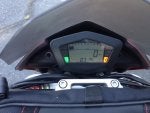Sorry for the delay - been busy !!!
First how it works : The thermistor is a device which changes resistance with temperature, with resistance dropping as temperature increases. As it is a resistor, it generates heat, which in turn reduces its resistance, generating more heat etc etc... When the thermistor is inside the fuel, the heat dissipation to the fluid is high enough that it exceeds the heat being generated by the thermistor and hence its temperature is stabilized at a certain level. However, when the fuel is low, and the thermistor is in air, the heat dissipation rate decreases, such that the thermistor starts to increase temperature. The fuel light works by putting the thermistor is series with a set resistance in order to deliver a designed current to the dash when the thermistor resistance ( as dictated by its temperature) rises above a defined value.
Measurements : Using a potentiometer in place of the thermistor it was possible to deduce that the light will come on when the thermistor resistance is below 160 ohms. By measuring the voltage drop over the potentiometer at various values it was possible to deduce that on the bike the thermistor is in series with a resistor of 116 ohms. What has happened to my stock sensor was that it was still generally working, but did not drop resistance far enough, hence the light did not come on.
Challenge : need to find thermistor which will provide the correct characteristics : resistance in fuel > 160 ohms, resistance in air < 160 ohms, but beyond this must have high resistance in fuel to avoid big constant current draw, and must be such that it doesn't go unstable ( heat up excessively) when exposed to air. Thermistors are defined by their B value, but generally also share their dissipation constant in air, and the current they will accept. Using this it was possible to build a system model, calculating resistance and hence heat generation, as well as the heat dissipation rate when in or out of the fuel. Of course, it is also somewhat important to make sure that the thermistor in air does not exceed the fuel auto-ignite temp, or the max temp permitted by the thermistor.
Result : using published properties, and knowing something of the application, I was able to select the Honeywell 135-202FAG-J01 with B value 3468K and dissipation in air of 2.5mW/degC. The nice part of this thermistor is that it is glass encased, and hence not affected by the fuel as I suspect the stock ones are. Cost was a whopping $1.47 a piece.
Testing : Bench testing was completed with 12v and a series resistor of 116 ohms to confirm that the thermistor selected responds as expected, and then I fitted it to the bike ( but not in the tank) and confirmed function by testing in and out of fluid. The fuel light worked as expected. As the worst case for the thermistor is when it is dry, I ran the thermistor in air for 24 hours constantly, and all seemed fine. However, this is as far as I got and never fitted the thermistor to the bike. I will when my light fails next time. To fit it, I'll need to dismantle the stock sensor, and fit the new thermistor in place of the old one.
BTW - note that the thermistor is mounted inside a can which has only small holes in it, such that the thermistor response is slowed and the light doesn't go on/ constantly when the fuel level is near the switch level.
So that's the status - the design is done, but not yet tested. Try it at your own risk !
Sent from Motorcycle.com Free App









